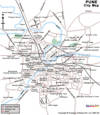 |
Map of the North and Central parts |
 |
A map |
 |
A map |
Photo Collection
Places
India
Puna (Poona)
12-13 January 1908. Speech at Poona.
Maps
Photos
Pune (Poona), city, Maharashtra state, western India, at the junction of the Mula and Mutha rivers, located 170 kms to the south of Mumbai. Called "Queen of the Deccan," Pune is the cultural capital of the Maratha peoples. The city first gained importance as the capital of the Bhonsle Marathas in the 17th century. It was temporarily captured by the Mughals but again became the official Maratha capital from 1714 until its fall to the British in 1817. It served as the seasonal capital of the Bombay Presidency and is now a popular tourist resort, offering cool weather (temperatures range from 15 degrees C to 35 degrees C; the best time to visit is October-March), historic and religious monuments, museums, and parks, hotels, and cultural attractions.
Pune has long been a major educational and cultural centre; Jawaharlal Nehru referred to it as the "Oxford and Cambridge of India." The city houses some 30 constituent and affiliated colleges of the University of Poona (1948); the Bhandarkar Oriental Research Institute (1917) is renowned for research and instruction in the Sanskrit and Prakrit languages and has more than 20,000 ancient manuscripts. Pune is also the headquarters of the southern command of the Indian army, with the Khadakwasla Academy located nearby.
A sprawling complex of industrial suburbs has developed around the city. Large factories producing a wide variety of products are distributed along the roads radiating from Pune to Bombay, Ahmadnagar, Sholapur, and Satara. The old city is largely residential and commercial and is served by large-scale commuter transport. In 1961 the Panshet Dam collapsed, washing away a substantial part of the old town.
The region surrounding Pune includes the Sahyadri Hills, the Balaghat Range (north), and the Mahadeo Hills (south), which enclose the northern Bhima River valley. Chief crops are jowar (sorghum), bajra (pearl millet), sugarcane, and rice. Most of the important religious, historical, and tourist attractions of the region are located in the Sahyadri Hills. Some of the famous hill forts of the Marathas, such as Sinhgad, have become modern resorts. The important religious centres include Bhimashankar, site of a Jyotirlinga shrine; Dehu, birthplace of the Marathi poet-saint Tukaram; Alandi, home of Jnaneshvara (Jnanadeva), author of a well-known commentary on the Bhagavadgita; and Karli, site of famous Buddhist caves. Nearby are Meherazad and Meherabad, sites associated with Meher Baba. Pop. (1981) city, 1,203,351; metropolitan area, 1,686,109.